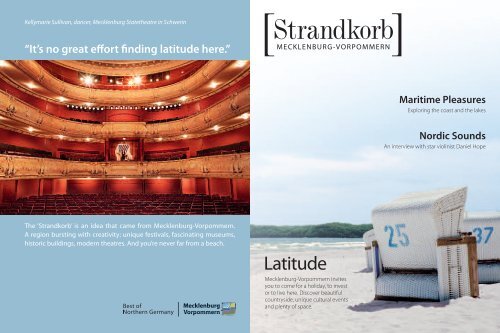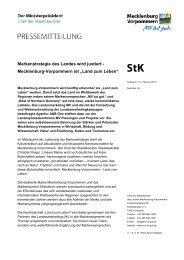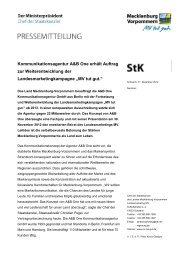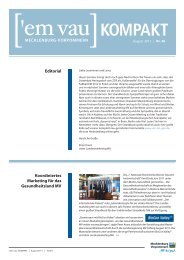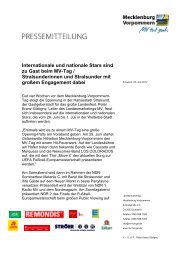Maritime Pleasures - MV tut gut
Maritime Pleasures - MV tut gut
Maritime Pleasures - MV tut gut
You also want an ePaper? Increase the reach of your titles
YUMPU automatically turns print PDFs into web optimized ePapers that Google loves.
Kellymarie Sullivan, dancer, Mecklenburg Statetheatre in Schwerin<br />
“It’s no great effort finding latitude here.”<br />
The ‘Strandkorb’ is an idea that came from Mecklenburg-Vorpommern.<br />
A region bursting with creativity: unique festivals, fascinating museums,<br />
historic buildings, modern theatres. And you’re never far from a beach.<br />
[ Strandkorb]<br />
MECKLENBURG-VORPOMMERN<br />
Latitude<br />
Mecklenburg-Vorpommern invites<br />
you to come for a holiday, to invest<br />
or to live here. Discover beautiful<br />
countryside, unique cultural events<br />
and plenty of space.<br />
<strong>Maritime</strong> <strong>Pleasures</strong><br />
Exploring the coast and the lakes<br />
Nordic Sounds<br />
An interview with star violinist Daniel Hope
Insight<br />
2<br />
A land full of possibilities<br />
The family of inventor Bartelmann<br />
in a 'Strandkorb' in 1884.<br />
[Strandkorb]<br />
pronounce [ˈʃtʀantˌkɔʁp]<br />
‘Strandkorb’. Maybe one of the loveliest<br />
words in German. It reminds us of<br />
relaxation, comfort and being out in<br />
the fresh air, space for ideas and<br />
personal freedom. No attempt at<br />
translation would do justice to that<br />
notion. The ‘Strandkorb’ is simply<br />
a place to be. It was invented<br />
in Mecklenburg-Vorpommern.<br />
According to history, Rostock court<br />
master basketmaker Wilhelm<br />
Bartelmann built the first one-seater<br />
‘Strandkorb’ for his wealthy client<br />
Elfriede von Maltzahn, who had<br />
rheumatism and wanted protection<br />
from the wind on the beach.<br />
The ‘Strandkorb’ quickly triumphed<br />
on German coasts and to date<br />
enjoys immense popularity.<br />
The ‘Strandkorb’ represents inventiveness<br />
and personal freedom,<br />
and not least because of this<br />
it symbolises the state of<br />
Mecklenburg-<br />
Vorpommern.<br />
A 'Strandkorb'<br />
on the Baltic<br />
coast today<br />
Mecklenburg-Vorpommern is Germany's gateway to Northern and Central Europe. Almost<br />
two thousand kilometres of coastline connect the state to Scandinavia and the Baltic Nations.<br />
The region, with a longstanding tradition going back to the time of the Hanseatic League,<br />
stands for freedom, ‘latitude’ and innovation. The ‘Strandkorb’ is testament to the fact that these<br />
values have a permanent place here. Nowadays, it is not possible to imagine the coasts of<br />
Northern Europe without this popular kind of beach furniture, which was invented in Rostock-<br />
Warnemünde in 1882. This was also the impression the representatives of international politics<br />
had in 2007 when, at the Heiligendamm G8 Summit, they took their places for a unique group<br />
photo in a large version of the ‘Strandkorb’.<br />
Tradition and innovation are also what the six universities of the state stand for. The universities<br />
of Rostock and Greifswald are among the oldest in the whole of the Baltic region and, like<br />
the aspiring universities of Stralsund, Neubrandenburg and Wismar, and the Rostock University<br />
of Music and Drama, regularly gain top-ranking positions. With their modern facilities, and being<br />
so close to water, they offer ideal conditions for studying and researching as well as recreation.<br />
Efficient networking between science and business moves their work forward in diverse ways.<br />
Above all, enterprises working in the areas of renewable energies, health management and the<br />
maritime economy know how to use the advantages of the location.<br />
Unique perspectives of a quite different kind are provided by Mecklenburg-Vorpommern's<br />
unspoilt natural areas. About 300 nature reserves, among them three national parks, eight<br />
nature parks and three biosphere reserves, delight visitors from all over the world.<br />
Photo Credits Cover, Page 2-3: State marketing <strong>MV</strong> (2), Wohn- und Geschäftshaus Bartelmann seit 1903 (1), www.shutterstock.de (1)<br />
The same applies to the numerous stately homes and manor houses with their ornate and<br />
appealing gardens. Wherein the past the painter Caspar David Friedrich had placed the<br />
landscape in the centre of his pictures, today majestic sea eagles and cranes still find unique<br />
resting areas. In Mecklenburg-Vorpommern, nature and culture go together, as the cuisine<br />
of the region proves. From the Baltic coast to the Mecklenburg lake district, chefs are creating<br />
a distinct culture of savouring high quality regional products. However, the enjoyment<br />
of art is also guaranteed in the summer, when international actors, singers and musicians<br />
play at many concerts and festivals in the state at picturesque and unusual locations. These<br />
locations are also used for successful film productions such as ‘The Ghostwriter’ by Roman<br />
Polanski and ‘The white Ribbon’ by Michael Haneke as the mysterious beaches and historic<br />
manor houses have shown Mecklenburg-Vorpommern in its best light.<br />
These places are ready to be discovered by you. On the following pages [Strandkorb] will<br />
introduce you to a land full of possibilities. Enjoy Mecklenburg-Vorpommern. And try to<br />
pronounce ['ʃtrant,kɔrp] and ['meːklənbʊʁç'foːʁpɔmɐn]!<br />
[ Strandkorb]<br />
MECKLENBURG-VORPOMMERN<br />
Contents<br />
Page 4 – 6 A Journey to popular places<br />
Page 7 Manor house dreams<br />
Page 8 – 9 Best of Northern Germany<br />
Page 10 –11 Northern statements<br />
Page 12 –13 ‘Strandkorb-Talk’ with<br />
Daniel Hope<br />
Page 14 Roger Boyes' view<br />
on the Strandkorb<br />
Page 15 Fine dining in<br />
Mecklenburg-Vorpommern<br />
I M P r I N t<br />
Publisher<br />
State marketing Mecklenburg-Vorpommern,<br />
Peter Kranz (V.i.S.d.P.)<br />
Schloßstraße 2-4, 19053 Schwerin<br />
Phone: +49 385 588 57 95<br />
Fax: +49 385 588 57 97<br />
info@mv-<strong>tut</strong>-<strong>gut</strong>.de<br />
www.mv-<strong>tut</strong>-<strong>gut</strong>.de<br />
Editing & Design<br />
Molthan van Loon Communications GmbH (GPRA)<br />
www.mvlcc.de<br />
Alexandra Sell, Stefanie Quaas<br />
Print<br />
Druckerei Hahn GmbH<br />
Circulation 15.000<br />
Editorial deadline October 2011<br />
3
Müritz National Park 53°25’0’’ N · 12°41’0’’ E<br />
A wild romance<br />
Artists for the pure northern light, escapists for the remote wilderness of islands like Rügen,<br />
Usedom and Hiddensee, culture enthusiasts for the almost 2,000 stately manor houses – all are<br />
captivated by Mecklenburg-Vorpommern. Whether seen from a canoe in the pristine<br />
Mecklenburg lake district or a ‘Strandkorb’ on the 1945 km Baltic coast, this is a region of<br />
extraordinary natural beauty. Where the country collides with the coast, UNESCOlisted<br />
Wismar, with its red-brick Gothic architecture, and Stralsund, with its vibrant harbour and<br />
award-winning Ozeaneum, signal a proud Hanseatic past.<br />
Wild and Wonderful _ “The only way to really see<br />
Müritz National Park's web of waterways and lakes<br />
is by boat,” Ranger Carmen Schnell tells me, as we<br />
glide across Görtowsee in a canoe. I nod in silent<br />
agreement. The lake is silver-grey and as flat as a<br />
mirror in the morning calm and as we paddle in<br />
quiet exhilaration, Carmen points out red kites and grey herons<br />
soaring overhead. We spot ‘otter slides’ on the reed-fringed banks<br />
and come across great crested grebes carrying their stripy chicks<br />
on their backs. “They’re loving parents,” Carmen grins.<br />
The splish-splash of summer rain mingles with the cuckoo's call as<br />
we reach Useriner See, one of many lakes carved out by the Havel<br />
River. “Every weather and season has its appeal here,” says Carmen.<br />
“In spring there's the breeding choruses of the blue moor frogs, in<br />
summer sea eagles and ospreys, in autumn the migration of cranes<br />
and in winter, total peace.” As the skies clear in the early evening,<br />
we paddle along sun-dappled channels to Blankenförde, where<br />
dragonflies flit and wooden boat houses reflect in the water. Suddenly,<br />
my heart skips a beat as a kingfisher, a flash of electric blue,<br />
darts out of the reeds.<br />
The next day we meet Peter Heyde, who has been a Ranger ever<br />
since Müritz National Park was founded in 1990. “We've come a<br />
long way in conservation recently,” he says enthusiastically. Peter<br />
alludes to the park’s 600 km of hiking and cycling trails, Serrahn's<br />
centuries old beech forests, designated a UNESCO Natural Heritage<br />
Site in July 2011, and the flooded forests of Zotzensee where a<br />
regeneration project has raised water levels in recent years.<br />
4<br />
[ ]<br />
In Speck, a nature trail leads us<br />
through a forest of tall pine and<br />
oak to ‘Käflingsbergturm’. From the<br />
tower, we gaze out across a neverending<br />
jigsaw of lakes and lush<br />
woodlands. “This was once a Soviet<br />
training ground. Now it is the virgin forest of tomorrow,” points out<br />
Peter. Indeed, from this vantage point, Müritz National Park is<br />
peaceful and primevally beautiful. Civilisation seems far away and<br />
nature that bit closer.<br />
»Every weather and season<br />
has its appeal here.«<br />
C A R M E N S C H N E L L ,<br />
Ranger Müritz National Park<br />
to the Manor Born _ An avenue of 200-year-old lime trees is a<br />
suitably grand entrance to Schloss Bothmer, the largest baroque<br />
palace in Mecklenburg-Vorpommern. Situated in the Klützer Winkel,<br />
the palace was rescued from its Sleeping Beauty-like slumber<br />
in 2008 and is gradually being restored to its former glory. Framed<br />
by a moat, the redbrick beauty was built by architect Johann Friedrich<br />
Künnecke between 1726 and 1732 for Count Hans Caspar von<br />
Bothmer, an advisor to the English Court of King George I.<br />
The palace truly comes to life at ‘BothmerTag’ in July. On a sunny<br />
Sunday morning, we join picnickers for an open-air classical music<br />
concert performed by the Mecklenburgische Staatskapelle Schwe -<br />
rin. Sprightly symphonies such as Franz Lehár's Merry Widow and<br />
Strauss' Radetzky March resonate in the gardens where Lords and<br />
Ladies once strolled. Stilt-walkers and performers in baroque costume<br />
parade for the crowds. Contemplating the intricate stucco<br />
and fireplaces in the palace interior, we imagine how magnificent<br />
the palace will be when restoration is complete around 2014. >><br />
Photo Credits Page 4-6: Andy Christiani<br />
Evening light in Binz: Impressive buildings right next to the beach<br />
Bothmer Palace: Vibrant heritage reingard Berger: Cooking in a rich traditional style<br />
Author Kerry Christiani and Park ranger Carmen Schnell: Boating on the ‘Görtowsee’ in the Müritz National Park<br />
Binz 54°24’0’’ N · 13°36’0’’ E<br />
5
Schloss Bothmer is a tantalising prelude to Mecklenburg-<br />
Vorpommern’s rich cultural heritage. Nestled amid coast and country<br />
are more than 2,000 castles and manor houses, unique to this region.<br />
Once the centrepiece of the village, the so called ‘Herrenhäuser’ wear<br />
their history with pride, from baroque to Biedermeier, neoclassical to<br />
Art Nouveau. Today, many form the atmospheric backdrop for events,<br />
while others have been converted into stately guesthouses.<br />
Central to the ‘Herrenhaus’ was the garden, a place of beauty and<br />
a source of fresh food. To find out more, we visit the UNESCO-listed<br />
Hanseatic town of Wismar, where red-brick Gothic buildings line<br />
the postcard-pretty old town. At organic Hotel Reingard, Reingard<br />
Berger is inspired by Herrenhaus cuisine. “As was tradition in manor<br />
houses, my menus allow each season to shine and feature lots of<br />
fruit in the main course,” she tells us. By candlelight we dine on wild<br />
herb soup with scallops, pikeperch served with apricots, and rose<br />
parfait with sour cherries – flavours that are summery, fragrant and<br />
delightfully reminiscent of a bygone era.<br />
romantic rügen _ There is a mystical air to the island of Rügen<br />
and it was this that drew the Romantics to its shores in the 19th<br />
century. They were enchanted by the pure Baltic light, the everchanging<br />
colours of the sea, the plunging chalk cliffs, and the ancient<br />
forests full of megalithic graves. Today, as then, Germany's<br />
largest island is a place of untouched nature and lyrical landscapes.<br />
Thatched cottages rise above poppy-studded cornfields,<br />
silver-grey beaches necklace the almost 580 km coastline and trees<br />
arch gracefully across cobbled roads. We follow the footsteps of<br />
6<br />
Jasmund National Park 54°33’7.2’’ N · 13°37’22.8’’ E<br />
the chalk cliffs of rügen: Hallmark of the Jasmund National park<br />
German romantic artist Caspar David Friedrich to the Jasmund National<br />
Park in the island's northeast. Here, trails thread through<br />
UNESCO-listed beech forests, which are like something out of a fairy<br />
tale with their gnarled stilt trees, swamps and tranquil lakes. Suddenly,<br />
the coast drops away and we are standing atop the wild chalk<br />
pinnacle of ‘Königsstuhl’ (118m), immortalised by Friedrich in his<br />
painting ‘Kreidefelsen auf Rügen’ in 1818. The force of nature and<br />
the lure of the sea are tangible as we walk further along the ragged<br />
cliffs to Victoria Viewpoint.<br />
From its clifftop perch nearby, Panoramahotel Lohme has sublime<br />
views along the coast to Kap Arkona from its terrace. “Lohme is<br />
Rügen’s cradle of Romantic,” expresses hotel manager, historian<br />
and philosopher Matthias Ogilvie. “Romantic writer Gerhard Hauptmann<br />
found freedom of expression here, and novelist Theodor<br />
Fontane compared it to Sorrento during his stay in 1884.” A selfconfessed<br />
Romantic, Matthias loves Rügen's open expanse of sea.<br />
“Feelings can flow freely here,” he says, as we wander through a<br />
coastal forest where maple and ash trees intertwine. “This is<br />
Rügen's Mondscheinallee, or lovers' lane,” he muses, pointing out<br />
hearts carved into tree trunks.<br />
As the light softens, we stroll along the grand promenade of Binz,<br />
a fine romance of a seaside resort with its ornate whitewashed<br />
villas, palatial spa hotel and rows of Strandkörbe. Nearby, Sellin has<br />
a watercolour dreaminess at dusk, with its pier aglow and the sky<br />
streaked purple, pink and gold. We truly agree that the romantic<br />
spirit of Rügen is still very much alive. Kerry Christiani<br />
Kerry and Andy Christiani<br />
Kerry and Andy Christiani are a freelance travel writer and photographer team based in Germany's<br />
Black Forest. Their Frommer's Marrakech Day by Day guidebook was awarded Travel Guide of the<br />
Year 2010 at the Travel Press Awards in London. Kerry frequently writes guidebooks for Lonely<br />
Planet, Frommer's, Thomas Cook and the AA, as well as articles for publications including BBC Olive,<br />
Emirates Open Skies and Lonely Planet Magazine. Andy is an approved Lonely Planet photographer,<br />
with names like National Geographic Traveler on his CV, and his images often illustrate Kerry's text.<br />
Visit www.kerrychristiani.com and www.andychristiani.com.<br />
Photo Credits Page 7: State marketing <strong>MV</strong>/ Carlo Zamboni (1), Gut Dalwitz (1)<br />
»We're living<br />
a family fairy tale«<br />
The way to the ‘Mecklenburger Parkland’ leads over bumpy<br />
cobblestones, along sunlit avenues and past small glittering lakes.<br />
Near Wallenstein's stately home in Güstrow lies the Dalwitz estate –<br />
a fairy tale come true for the ‘von Bassewitz' family. However,<br />
the story begins in far away Uruguay.<br />
It was here that the Uruguayan Lucy Henderson met Count Heinrich<br />
von Bassewitz, who was then working for the German Company for<br />
International Cooperation (GIZ). By the campfire, she listened to his<br />
old family stories about a heavenly place in Mecklenburg, where in<br />
May busy bees buzz in the lime trees in the late afternoon: the<br />
Dalwitz estate. The Agricultural Economics PhD graduate wanted<br />
to lease back the expropriated family property and cultivate it,<br />
preferably using organic farming methods. The appeal of these<br />
stories and the passion of the storyteller must have been persuasive,<br />
as only two weeks later, Lucy accepted his proposal of<br />
marriage and moved despite her aunt's plaintive warnings “it's a<br />
white elephant, it will eat you” – to Mecklenburg. The first visit to<br />
the derelict buildings of the former grand Dalwitz estate was both<br />
sobering and motivating at the same time. They both worked<br />
hard on the farm and in the estate buildings. Looking back, the<br />
Countess said: “We both have lots of energy, so I always knew we<br />
would succeed.” The manual work was hard but enjoyable for her.<br />
While strolling across the courtyard, Lucy von Bassewitz explains<br />
enthusiastically: “I love the countryside here – particularly in May<br />
when everything turns green and the rapeseed, gold.”<br />
Daybreak in the garden of Dalwitz manor house<br />
Countess Lucy with her youngest son<br />
Dalwitz Rostock 53°58’0’’ 54°5'0''N N · 12°33’0’’ · 12°8'0''OE<br />
The lady of the manor's South American charm and hospitality is<br />
palpable everywhere on the idyllic estate in Mecklenburg. Every<br />
Monday there's a South American Asado in the park, a barbecue for<br />
the holiday makers, Criollo horses gallop over the meadows and<br />
sometimes Lucy cooks ‘Dulce de Leche’, a dessert made with milk<br />
and sugar. She has a few plans concerning this dessert: “My dream is<br />
to produce ‘Dulce de Leche’ and jams too, on the Dalwitz estate and<br />
sell them.” The South American lady never runs out of business<br />
ideas.<br />
Today, three happy Bassewitz children are playing again, just as previous<br />
generations before them, beneath the gnarled lime trees, in<br />
which the bees buzz so delightfully in the late afternoon. That is the<br />
reason why, despite missing her family in Uruguay, Lucy is quite<br />
clear: “I'm going to stay in Mecklenburg-Vorpommern. We are living<br />
a family fairy tale here.”<br />
7
Places to be<br />
Whether you go by boat, car, plane or train, Mecklenburg-Vorpommern is always worth a visit. You can look forward to a<br />
rich and varied countryside and diverse fauna especially in Mecklenburg-Vorpommern's fourteen large nature reserves.<br />
You can also go on a journey of discovery to museums, theatres and artists' communities, as the region was a retreat, source<br />
of inspiration and home to many well-known artists, writers and musicians.<br />
The architecture in Germany's north-east is impressive: red brick Gothic is typical for the region and in the Hanseatic towns<br />
of Wismar and Stralsund has been designated part of our world heritage by UNESCO. Also included among the region's<br />
special architectural features are the piers along the Baltic coast and more than 2,000 manor houses further inland.<br />
Whether you're interested in nature, culture or architecture, it's particularly worthwhile making<br />
a trip to these special places.<br />
GErMANY<br />
Nature Protection Area<br />
Ferryport<br />
Airport<br />
Bothmer<br />
Castle, Klütz<br />
A20<br />
Church of<br />
St. Georgen,<br />
Wismar<br />
A24<br />
Photo Credits Page 8-9: State marketing <strong>MV</strong> (3), Jens Büttner (1), Rainer Cordes (2),<br />
Dr. Christiane Wolff (1), Andy Christiani (1), Pommeranian State Museum (1),<br />
Photo Agency imago (2); Graphic: T<strong>MV</strong>/ Werk 3<br />
UNESCO<br />
World Heritage Site<br />
Wismar<br />
Old Synagogue<br />
Hagenow<br />
State Museum<br />
Schwerin<br />
State Stud Farm<br />
at redefin<br />
Schwerin<br />
Castle<br />
Ludwigslust<br />
Castle<br />
First German<br />
Seaside Health resort<br />
Heiligendamm<br />
Bad Doberan<br />
Minster Old racecourse<br />
for horses,<br />
Bad Doberan<br />
Barlach's<br />
Floating<br />
Angel,<br />
Güstrow<br />
A24<br />
Climatic Spa<br />
Plau am See<br />
Artist's Colony<br />
Ahrenshoop<br />
University<br />
rostock<br />
Journey through<br />
Evolution<br />
DArWINEUM<br />
Güstrow<br />
Castle<br />
Golf Course<br />
Fleesensee<br />
A19<br />
Manor House<br />
Dalwitz<br />
8 9<br />
Motorcross<br />
racecourse<br />
teterow<br />
Ocean<br />
Museum<br />
OZEANEUM,<br />
Stralsund<br />
Nature Discovery<br />
Center<br />
MÜrItZEUM,<br />
Waren<br />
Mirow Castle<br />
Light House<br />
Dornbusch,<br />
Island<br />
Hiddensee<br />
UNESCO<br />
World Heritage<br />
Site Stralsund<br />
Heinrich-<br />
Schliemann-<br />
Museum,<br />
Ankershagen<br />
University<br />
Greifswald<br />
Pome ranian<br />
State Museum,<br />
Greifswald<br />
Hans-Fallada-<br />
Museum,<br />
Carwitz<br />
Baltic resort<br />
Binz<br />
Pier Sellin<br />
Otto-Lilienthal-<br />
Museum,<br />
Anklam<br />
Three<br />
Emperor's<br />
Spas,<br />
Usedom<br />
Town of<br />
four Gates,<br />
Neubrandenburg<br />
A20<br />
Chalk<br />
Cliff<br />
Rügen<br />
Europe's longest<br />
Boardwalk,<br />
Usedom/Poland
People from<br />
Mecklenburg-Vorpommern<br />
“For me Mecklenburg-Vorpommern is a land of luxury. Here I can do what I love:<br />
gardening in a clean environment, cooking with the best products, enjoying the<br />
beautiful countryside with my family and working with nice people. The fact that<br />
Hamburg and Berlin are so near isn't a bad thing either!”<br />
“The most beautiful Dutch can be found<br />
in Mecklenburg-Vorpommern!”<br />
Dr. Dirk Blübaum is the Director of the Schwerin State<br />
Museum, which is famous for its collection of<br />
17th and 18th century Dutch masters, with works by<br />
Rubens and Rembrandt – even outside the state.<br />
“Hollywood is far away –<br />
and that is a good thing.”<br />
Although actor Hinnerk<br />
Schönemann has previously<br />
worked with Steven Spielberg,<br />
he would not exchange<br />
the movie Mecca for his<br />
homeland <strong>MV</strong>. In Plau am See<br />
he particularly enjoys<br />
the peace and quiet – and<br />
the people of Mecklenburg.<br />
Olaf Schnelle is a market gardener and a re-discoverer<br />
of wild herbs and flowers, which he and chef<br />
Ralf Hiener, sell to top international restaurants<br />
via the company Essbare Landschaften GmbH<br />
(‘Edible Landscapes’) of Boltenhagen<br />
in Vorpommern.<br />
“I'm serious: The Queen<br />
comes from Mecklenburg-<br />
Vorpommern!”<br />
Angelika Groh is the Manager<br />
of the 3-Königinnen-Palais<br />
(‘Three Queens Palace’)<br />
on the idyllic Schlossinsel<br />
(‘palace island’) in Mirow,<br />
the birthplace of Sophie<br />
Charlotte (1744-1818),<br />
crowned Queen of England<br />
250 years ago.<br />
“Bilbao, London, Stralsund – we are proud of having<br />
won the award of European Museum of the Year.”<br />
Marine biologist<br />
Dr. Harald Benke is a<br />
whale researcher<br />
and Head of the<br />
Stralsund <strong>Maritime</strong><br />
Museum ‘OZEANEUM’,<br />
which in 2010 was<br />
awarded the title of<br />
European Museum<br />
of the Year.<br />
“Mecklenburg-Vorpommern<br />
is in every one of our<br />
AIDA ships.”<br />
Michael Thamm is President<br />
of the shipping company<br />
AIDA Cruises, the German<br />
market leader in cruise shipping.<br />
At its headquarters in Rostock<br />
harbour and onboard, AIDA<br />
Cruises employs a workforce<br />
of more than 5,600 from<br />
25 countries.<br />
“Now we are reaping the rewards:<br />
Mecklenburg-Vorpommern will be<br />
a region that people deliberately<br />
choose to live in – because here,<br />
nature is still unspoilt.”<br />
Prof. Dr. Michael Succow is an expert on<br />
fenlands at the University of Greifswald and<br />
head of a foundation for environmental<br />
protection named after him. In 1997,<br />
he received the Right Livelihood Award<br />
for his involvement in international<br />
environmental protection projects and<br />
for setting up Mecklenburg-Vorpommern's<br />
three national parks.<br />
“Rostock is our Silicon Valley. There are clean ideas<br />
growing here, electrifying thousands.”<br />
Thomas Richterich is CEO of the<br />
internationally active Nordex SE group.<br />
This constructor of wind energy<br />
plants employs about 1,000 people –<br />
particularly in the areas of<br />
development and manufacture –<br />
at its Rostock site. The Nordex group<br />
has sponsored a professorship<br />
for ‘wind energy technology’<br />
at the University of Rostock.<br />
“We've already been to the most<br />
beautiful places in the world for<br />
competitions. But we still prefer<br />
to race in our home region,<br />
whether it's speed boat racing,<br />
cycling or running.”<br />
Brother and sister Andreas and Anja<br />
Dittmer from Neubrandenburg are very<br />
successful athletes. Andreas has already<br />
won three Olympic Gold Medals<br />
canoeing in Atlanta, Sydney and Athens.<br />
His younger sister will be taking part in<br />
the triathlon at the London Olympics.<br />
“Having my own pharmaceuticals company<br />
in Mecklenburg-Vorpommern, I feel like a bee<br />
in clover as far as research is concerned. We<br />
have great universities and insti<strong>tut</strong>es here<br />
that carry out application-based research.“<br />
Dr. Dagmar Braun is the Head of Braun Beteiligungs<br />
GmbH; she is a doctor of medicine and university<br />
lecturer, actively engaged as a business ambassador<br />
and is also Chairperson of the health network<br />
BioCon Valley M-V e.V.<br />
10 11<br />
Photo Credits Page 10-11: State marketing <strong>MV</strong>/ Carlo Zamboni (4), Edible Landscapes (1), State Museum Schwerin (1), Photo Agency imago (1), Nordex SE (1), Dr. Dagmar Braun (1), Neubauer (1), www.shutterstock.de (1)<br />
Seaside at the peninsula ‘Fischland-Darß-Zingst’
Schwerin 53°38’0’’N · 11°25’0’’E<br />
Daniel Hope was born in 1974 in Durban, South Africa, but grew up<br />
in London where, aged just four, he began to play the violin. He was<br />
taught by Yehudi Menuhin and studied at the Royal College of Music.<br />
Daniel Hope has been the Artistic Partner of the <strong>MV</strong> Festival since<br />
2009 and became the Artistic Director in 2011. With his musical series<br />
‘Hope's Music’, he is establishing links with the United States. Daniel<br />
Hope, who has adopted Mecklenburg-Vorpommern as his home, is<br />
making good use of his international contacts, including those at<br />
Carnegie Hall in New York. In his amusing guide for concert-goers, he<br />
throws light on the question, among others, “When may I clap?”. This<br />
exceptional violinist has already been awarded the sought after music<br />
prize ‘Echo Klassik’ five times.<br />
12<br />
Photo Credits Page 12-13: State marketing <strong>MV</strong>/ Carlo Zamboni (2), Translation: Robert Grözinger<br />
In an exclusive ‘Strandkorb’ interview at the Oudry Hall of the State Art Museum in Schwerin,<br />
violinist and artistic director of the Festival Mecklenburg-Vorpommern, Daniel Hope,<br />
explains how his desire for chewing gum made him into a star violin player and how<br />
he would perform a concert in a ‘Strandkorb’.<br />
»This land is definitely<br />
Mr. Hope, can you imagine performing a solo concert in a<br />
‘Strandkorb’? Yes, for sure. Of course I'd have to be careful<br />
with the violin bow. But the acoustics would certainly be good<br />
– like in a music shell.<br />
How did you come to choose your instrument, the<br />
violin? When I was still very little, my family moved from South<br />
Africa to England. My father, who was a writer, was unable<br />
to find a good job. However, my mother was offered an<br />
interesting job as secretary to the great violinist Yehudi<br />
Menuhin. Originally employed for six months, she stayed with<br />
him for 26 years until his death. So I grew up surrounded by<br />
music – and that led me to the violin.<br />
It is difficult for musicians to make a living. When did you<br />
decide to try it anyway? Back then I asked my father if, as a<br />
famous violinist, I would have enough money to buy chewing<br />
gum. He said to me: “If you practise every day and get to be really<br />
famous, you can buy as much chewing gum as you like.”<br />
That convinced me. Nowadays I buy a lot of chewing gum.<br />
the state of Mecklenburg-Vorpommern is typically Nor -<br />
thern German, maritime and offers latitude. Does this<br />
apply to the Festival as well? Absolutely! The Festival<br />
Mecklenburg-Vorpommern offers a unique artistic and musical<br />
experience in a setting that appeals to everyone. So it’s<br />
relatively easy for me to do my job as artistic director of the<br />
Festival Mecklenburg-Vorpommern and persuade my friends<br />
in other countries to come here. Sometimes it's difficult for<br />
them to pronounce ‘Mecklenburg-Vorpommern’, but I have<br />
a major key.«<br />
practised it with them. Once they're here and experience the<br />
festival – the atmosphere, the audiences, the countryside,<br />
the fantastic stately homes – they all want to come back.<br />
If you were to describe this land musically, would it be<br />
a major or a minor key? Definitely a major one.<br />
What does Mecklenburg-Vorpommern offer you personally?<br />
Latitude. I think there's a great deal of variety<br />
in this state. There are so many towns, villages, churches,<br />
museums and stately homes to go and see. You can say the<br />
same of the Festival Mecklenburg-Vorpommern: they combine<br />
international success with an informal atmosphere.<br />
This combination in a unique landscape is what excites me<br />
and many of my fellow musicians about <strong>MV</strong>.<br />
What can visitors expect to find at the Festival? Since<br />
1991 in more than 100 concerts and in locations all over the<br />
state, the Festival Mecklenburg-Vorpommern has been<br />
presenting international stars, up-and-coming artists and<br />
great orchestras in incomparable settings every year. The<br />
castles of Ulrichshusen, Hasenwinkel and Bothmer are just a<br />
few examples of the many, beautiful surroundings where we<br />
have our concerts. Furthermore, we're extending our international<br />
links year on year, presenting for example Carnegie<br />
Hall and Lincoln Center, America's two most important musical<br />
insti<strong>tut</strong>ions, in Mecklenburg-Vorpommern. There are<br />
new musical highlights every day – especially in summer. So<br />
all I can say is: come as quickly as you can to Mecklenburg-<br />
Vorpommern!<br />
13
An Extension<br />
of the Beach Towel<br />
Syndrome<br />
Imagine a beach. Out to sea there is nothing but endless blue;<br />
seagulls screech like Apaches; a sailboat winks in the distance.<br />
The sand is fine-grained, blond. An idyll. Suddenly you raise your<br />
eyes from the pink shells and squint towards the dunes. Lined up<br />
in front of you are row upon row of shrunken garden sheds.<br />
In military formation, like a forward defence line. An aesthetic<br />
disaster: upended coffins made from the kind of cheap wicker<br />
normally used for laundry baskets.<br />
Is there anything quite as ugly or inappropriate as the Strandkorb?<br />
[…] I have seen more graceful constructions on Sverdlovsk<br />
housing estates than the sight that greeted me recently on the<br />
Baltic Sea. The Strandkorb creates a womb for the holiday-maker<br />
who wishes that he had never left home. It cuts off the reluctant<br />
14<br />
Column<br />
sun-worshipper from his neighbours, blocks them from view.<br />
It is the seaside equivalent of the Schrebergarten (allotment garden).<br />
Strandkorb occupiers – even if they have paid only five<br />
euros for the day – feel as if they are part of a community, somehow<br />
superior to the people sitting on mats, getting grains of sand<br />
between their toes. […]<br />
The British have a different understanding of a beach. If wind is a<br />
problem (and it surely is on German and British coasts) then they<br />
dig a hole, a deep hole, and then surround it with a low canvas<br />
wall, a wind break. You use nature itself to protect yourself against<br />
nature; that is what you learn when you live on an island (even a<br />
crowded, noisy one like Britain). The truth is, the wind is part of<br />
the fun of being at the seaside; kites fly, skirts get blown up.<br />
So you accommodate yourself: you take a deckchair which you<br />
can turn to catch the sun. It's open, flexible, light to carry and you<br />
can sleep on it. What more do you want? The Strandkorb is the<br />
exact opposite.<br />
The Strandkorb though fulfills a German psychological need. It is<br />
an extension of the beach towel syndrome. Germany, at the time<br />
of the Kaiser, had few colonies, and no ‘place in the sun’. And its<br />
industrialisation came late – it was a ‘verspätete Nation’ (late developer).<br />
Germany drew conclusions from both historical misfortunes<br />
and resolved never to be late again. As a result, by six<br />
o'clock every morning, the sun-loungers around the swimming<br />
pool of every hotel on the Anglo-German (and nominally Spanish)<br />
island of Majorca are covered with German towels, reserving<br />
them for the rest of the day. And by eight o'clock on the same<br />
day, the sunbeds on the beaches have been occupied. British<br />
tourists, waking late after a night trying to boost their blood alcohol<br />
levels, find that the Germans are in occupation. They complain,<br />
they smear honey on the enemy towels to attract flies,<br />
mosquitoes and wasps, but they accept their fate. The Strandkorb<br />
is like a beach towel with a lead weight attached to it.<br />
R O G E R B O Y E S<br />
This is an extract taken from an article written<br />
by Roger Boyes for the book “The Strandkorb –<br />
A Global Champion from Mecklenburg-<br />
Vorpommern,” published in 2008 by Hinstorff<br />
Verlag. The author Roger Boyes reported from<br />
Germany as correspondent to ‘The Times’ and<br />
wrote columns for the Berlin ‘Tagesspiegel’<br />
until summer 2011. Born in 1952 in Hereford,<br />
the journalist and author is known especially<br />
for his biting ironic cultural-anthropological observations of the Germans from<br />
a foreigner's perspective. His bestseller ‘My dear Krauts’ appeared in 2006,<br />
followed by ‘How to be a Kraut’ in 2007 and ‘Ossis forever!’ in 2010.<br />
Photo Credits Page 14-15: State marketing <strong>MV</strong>/ Carlo Zamboni (1), T<strong>MV</strong> / Neumann (1), laif Photo Agency (1), www.shutterstock.de (1)<br />
Outlook<br />
President George W. Bush, chancellor Angela Merkel and President<br />
Vladimir Putin – they were all fortified by a meal created by him<br />
before they gathered for a group photo in a ‘Strandkorb’ at the<br />
2007 G8 Summit in Heiligendamm. Then, as now, chef Tillmann<br />
Hahn relies on first class products from local organic farms for his<br />
internationally inspired dishes. There is a wealth of meadows,<br />
woodland and fields in these expansive and unspoilt landscapes<br />
of Northern Germany. In addition, there is the Baltic Sea, the<br />
Müritz Lake and almost 2,000 other lakes, where delicacies such as<br />
whitefish, saltmarsh zander and wild carp swim around. With these<br />
ingredients, the region's chefs prepare culinary delicacies using<br />
traditional methods with contemporary lightness and invite us to<br />
savour Mecklenburg-Vorpommern with all our senses.<br />
Heiligendamm 54° 8′ 34’’N · 11° 50′ 38″E<br />
[ ]<br />
»For me, diverse cultural landscapes, first class ingredients, traditional cuisine and warm hospitality<br />
go inextricably together. That is why, despite the international orientation of my cuisine,<br />
I still prefer to use local, traditionally produced food. In this way, foreigners become friends,<br />
producers become valued partners and I can serve my guests uniquely fresh and distinctive food«<br />
T I L L M A N N H A H N<br />
Tillmann Hahn is a Michelin-starred chef at the Yachthafenresidenz Hohe Düne in Rostock-Warnemünde.<br />
In 2007, while still at the Grand Hotel Heiligendamm, he cooked for the international<br />
heads of government at the G8 Summit (see page 2–3).<br />
Regional cuisine with international flair<br />
15


